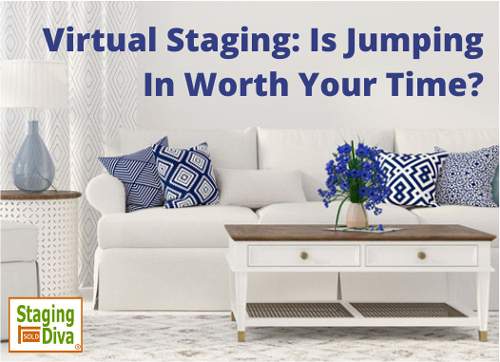 There’s been a lot of talk about virtual home staging.
There’s been a lot of talk about virtual home staging.
As the technology improves, it’s only natural to wonder whether virtual home staging will replace the real thing.
Virtual home staging is done by computer. This eliminates the need for physical furniture and accessories.
Potential buyers will see what’s possible for each room, without the expense of putting real items in place.
As you can see from this photo, this is a pretty convincing family room set up. At first glance at least.
However, when you look closely at the curtains on the left, you’ll notice they aren’t real. I purchased this image from a stock image site and it wasn’t marked whether it was an actual photograph or computer generated.
And does anyone care?
Imagine if this virtual home staging photo showed more of the room. Would it be an acceptable listing photo? Yes, it would do a much better marketing job than showing a vacant room.
Because people are attracted to “homes” not empty houses.
I’ve long written about why home staging works. In a nutshell it romances the buyer. When done well, home staging showcases a home’s best features. It helps buyers fall in love while they imagine a new chapter in their lives living in this “dream home.”
Virtual Staging Disappears As Soon As You Visit in Real Life
The problem with virtual home staging is that at some point the potential buyer will want to see the home in person before making an offer.
That’s when they’ll be wandering through empty rooms. Let’s face it, unless it’s brand new, most vacant homes look kind of sad. Buyers will notice every ding on a wall, every old furniture mark in the carpeting, the cable wires hanging out of the walls, etc.
They’ll wonder if the seller is desperate to sell because they don’t live there anymore.
And if they owner is still living there, they’ll wander through rooms that look nothing like the listing photos that attracted them in the first place.
These factors alone are why I’m not a fan of virtual home staging. It won’t romance buyers and get them caught up in making an offer when they’re seeing the home in real life.
If you’re in a real estate market with lots of foreign buyers or property investors, perhaps these concerns are less of an issue. The potential buyers aren’t buying their home, they’re buying an investment they’ll rent out, or leave empty.
Should You Learn Virtual Home Staging Software?
If you’re a home stager, you might be wondering whether learning virtual home staging software is a good idea. After all, it would give you the option of selling this service to clients who are resistant to investing in real home staging.
Here’s the problem, there are plenty of companies offering this service already. And it’s very cheap because they likely farm the work out to third world countries. Or really underpay the people doing it for them.
I’ve seen virtual home staging offered for as little as $25 per room/photo. Where’s the profit in that?
In my opinion, unless you love the idea of learning new software and sitting in front of a computer creating imaginary rooms, then you’re better off letting someone else do the actual photo manipulations.
So if you really want to offer this service, you can find someone else to implement your design ideas.
Share Your Opinion
Home stagers, what do you think? Do you feel it’s worth jumping into learning virtual home staging? I’d love to get a good discussion about this going! Simple share in the comments below. 😃



I have been offering it because I already do virtual designs for the Edesign part of my business, so I didn’t buy one of those staging software programs or have to learn something new. i think what I create looks better than what others generate for a much cheaper price but find most people looking for virtual staging don’t care about the extra level of quality compared to price so they will go with the $25 rooms.So it has not been very lucrative for my business. And I agree, it is always better to stage in person if at all possible because as soon as a buyer sees the vacant space, it will be a disappointment. The virtual staging may also be somewhat misleading for listings, because no matter how clear you make it, many people will not read and then may be upset when they see it and it is vacant. Still, I think it can be a big help though for buyers to see how a property can look and how things will fit instead of just having the option of seeing a vacant space. So I think virtual staging is more helpful to buyers than no staging. I think it could also be valuable for rental properties that are normally rented vacant, model homes, real estate investors.
Thanks for commenting Mary Ann and sharing your experience. I totally agree that it’s most valuable for rental properties and real estate investors.
I agree vitual home staging can leave potential buyers very disappointed.
I agree with you. Virtual staging won’t romance the buyer the same way.
Agents may use it to save money and to present their listing the very best way possible but somehow it will be misleading. At the open house and when potential clients will book a showing, they will be deceived and I imagine they will have a lot of questions about why the house looks different from the listing that encouraged them to consider visiting. I wonder if the listing agents will inform potential buyers that “it was only a virtual staging” or not?
If I was to learn how to use the software, it would be for those clients who prefer the DIY options suggestions or those who are resistant to investing in physical staging as you mentioned above.
Thanks for commenting Marie! Great to hear from you.
Quick Tip: You can have your headshot appear wherever you make blog comments online. All you have to do is get a free Gravatar. I explain about it here.